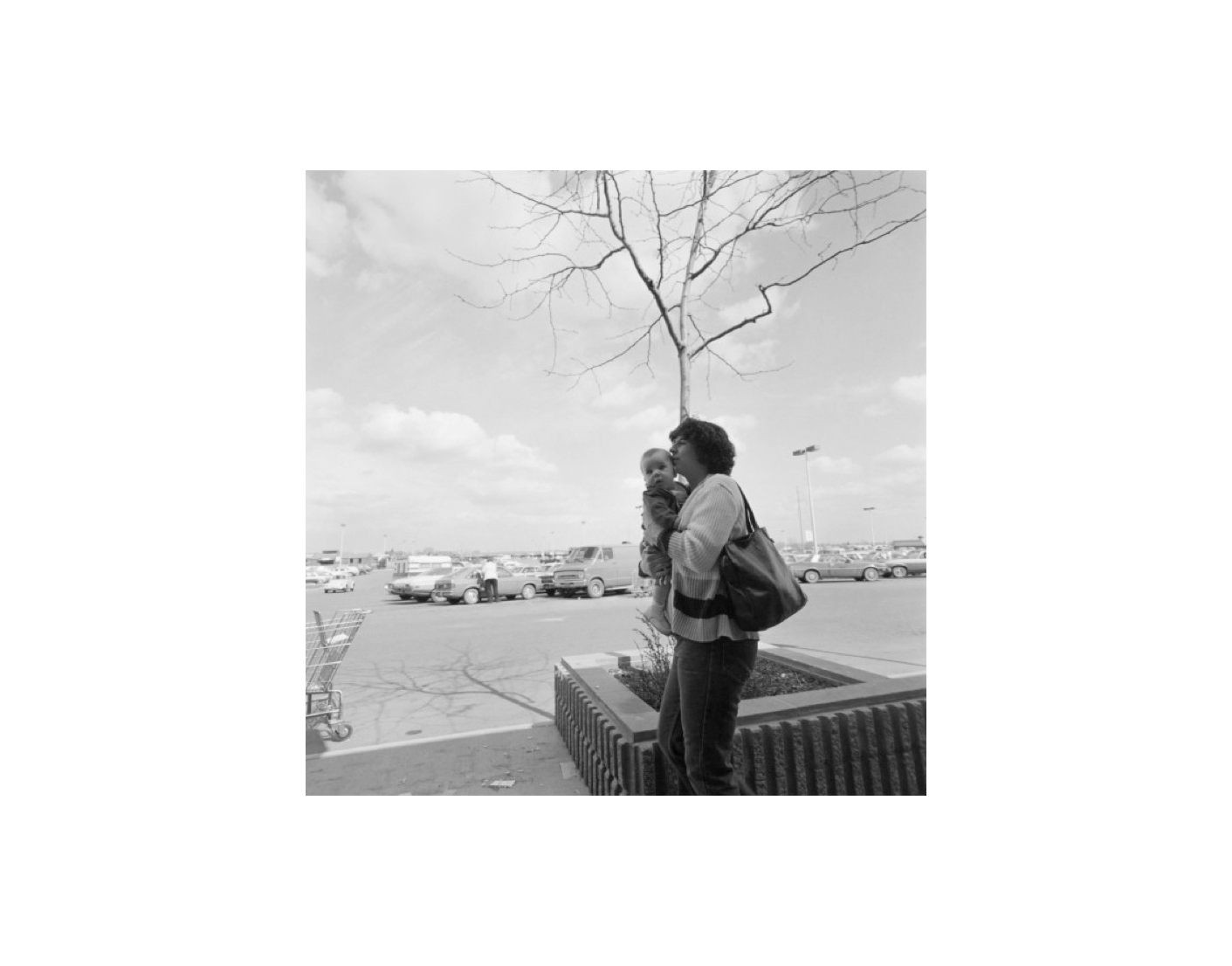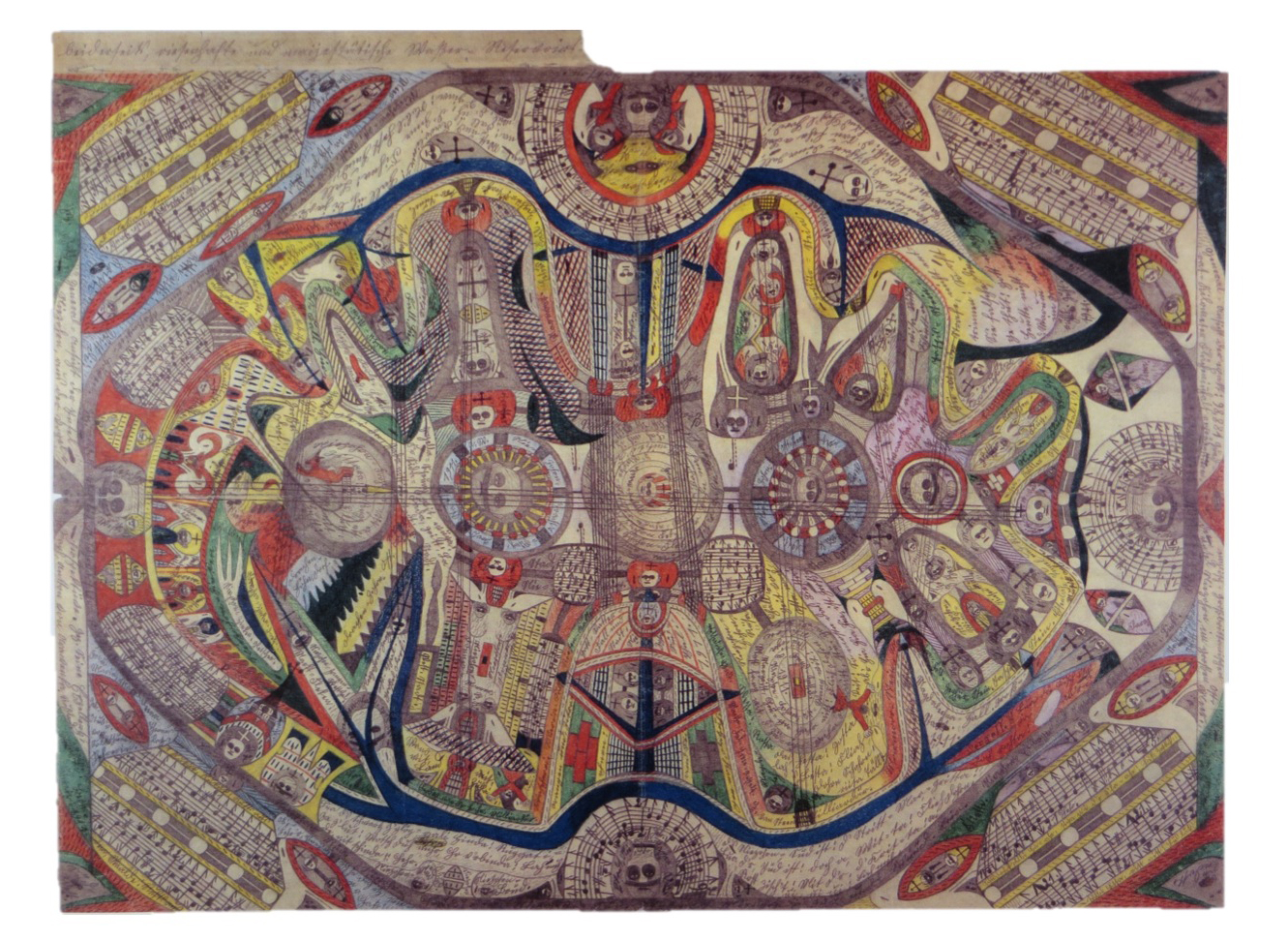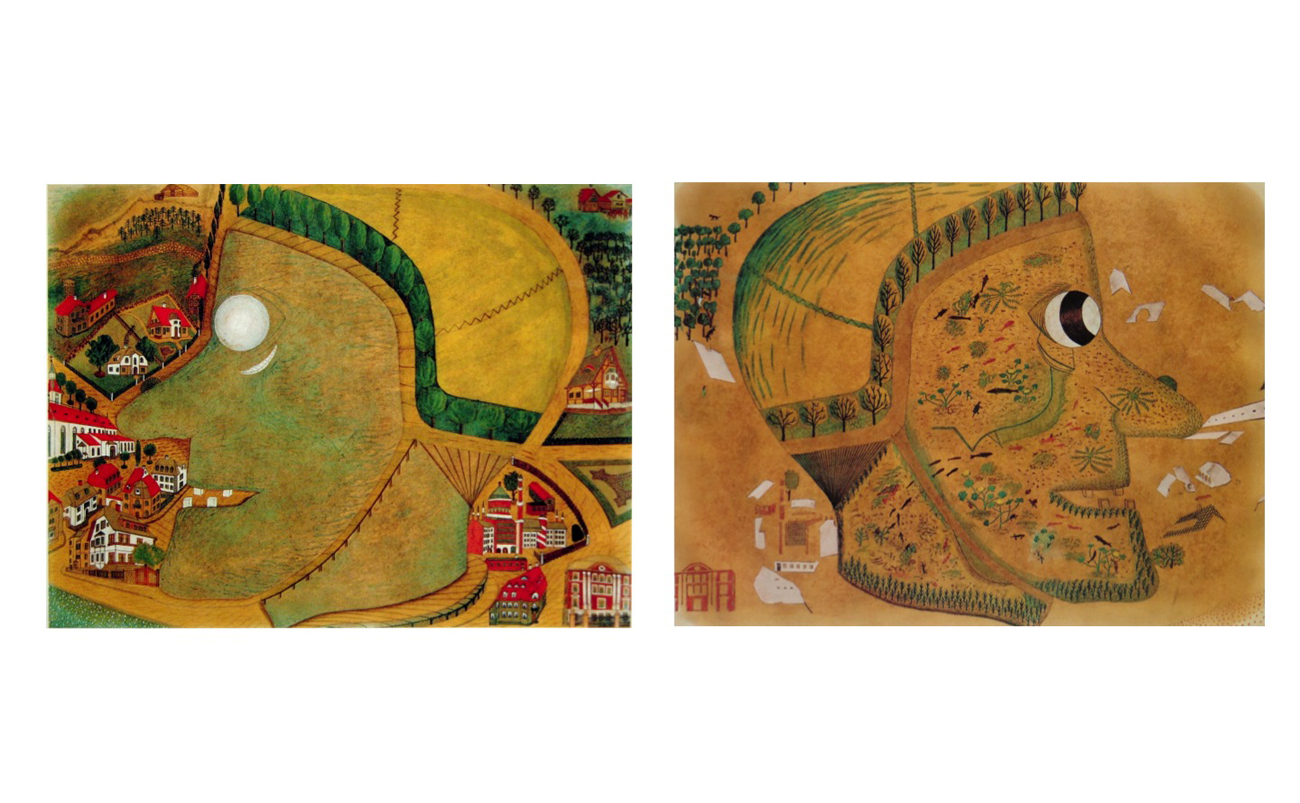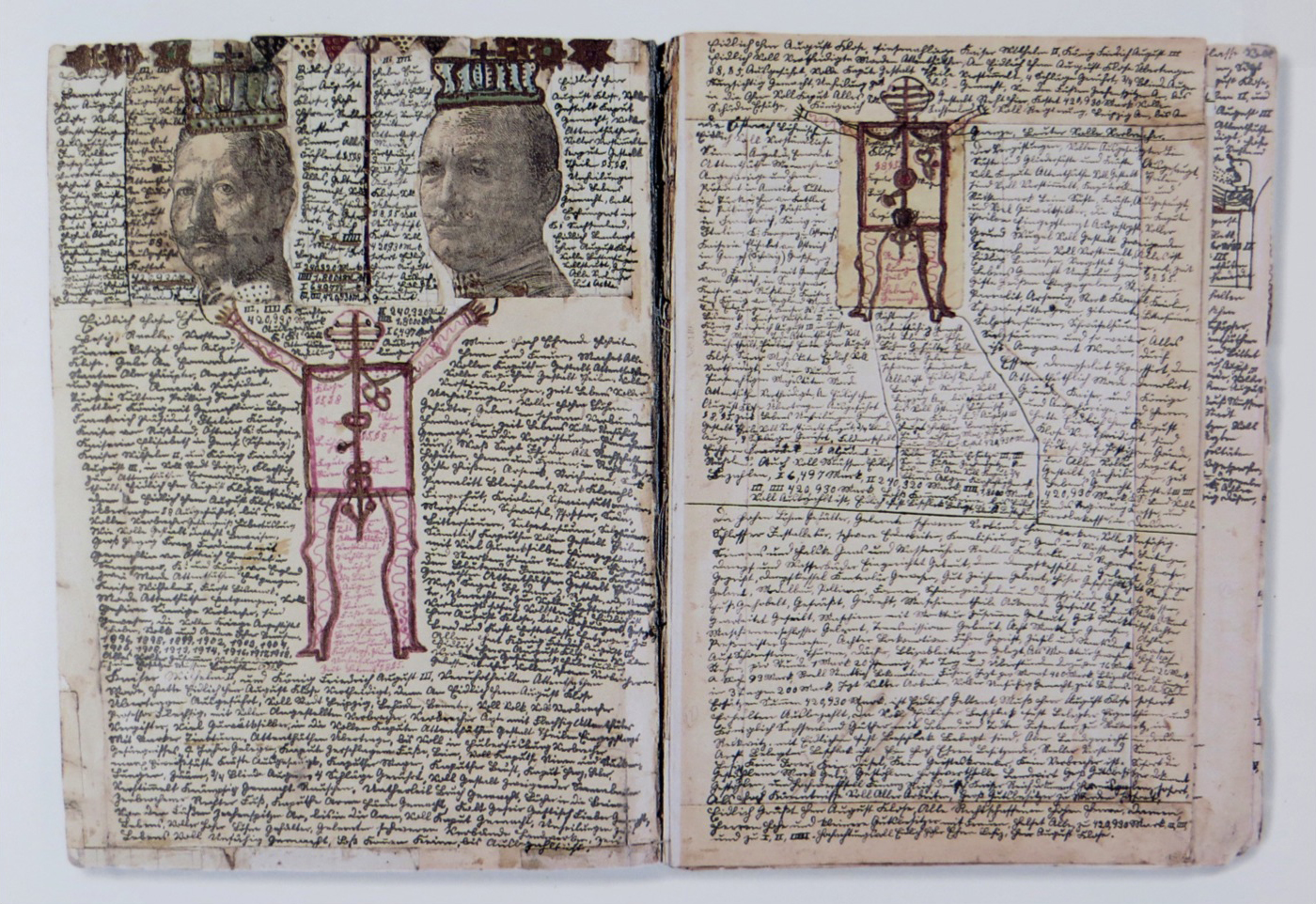As I said, I would like to explore further the critical content of the experience of territorial intimacy, as it is interpreted by the photographic or pictorial image. We will need to take into account cinema, which obviously has the advantage of including movement and speech. But I think it useful and necessary to question the sphere of the fixed, static image, and in particular photography. This allows us, for one thing, to examine the parameter of sight as a fixing of visual facts, as it appears in the still, silent image, without movement or sound.
I will however make an allusion to the importance of sound and rhythm in actions and behaviours linked to an everyday activity, outside its representation. I shall say a few words about poetic listening.
I am putting to one side the question of performance, but I shall give a few indications about the role of ritual symbolism in territorial intimacy. We shall see that ritual form implies not only a transformation of the body-image (Paul Schilder) but also, as Raoul Hausmann put it, body relations. The territory is at once the place of these relations and one of the things they put into play. A reflection on the critical content of images of territorial intimacy cannot ignore the answer brought by responses to crisis situations. The critical image is primarily a crisis image, that is to say, also, an image that in itself constitutes a critical moment.

Robert Adams, On Top of the La Loma Hills, Colton, California, 1983. From the portfolio Los Angeles Spring © Robert Adams, courtesy Fraenkel Gallery, San Francisco
In French, the word “vue” can mean both sight, the ability to see, and a visible portion of the world isolated by framing and the work of composition: both sight and view. In the historical typology of painting, sight/view corresponds to the veduta which, since the late seventeenth century, has designated the exact (objective and verifiable) representation of an identified site. Photography has consolidated the norm of objectivity by giving painters, as Francis Wey observes, a criterion of the true, established by the “pure and veridical reproduction of nature” (La Lumière, 9 February 1851). At the same time, recording made pictorial description pointless, superfluous. According to Wey, the criterion of photographic exactitude was not a paralysing constraint for painters; on the contrary, they could and no doubt did see it as the guarantee of a new freedom of interpretation, freed both of descriptive naturalism and of the clichés (or hackneyed formulae) of academic idealisation.
I will not, here, go back over the problematic of the relation between painting and photography, which arose in the nineteenth century in the context of debates over realism. However, the case of Robert Adams, currently being exhibited at Jeu de Paume, raises questions about the relation between “pictural” idealisation (in the broad sense of that adjective: pictorial) and the critical content of photographic reportage.
In the field of representations of landscape, to which the idea of territorial intimacy is in part attached, the pastoral genre was a constant vector of idealisation, and artists who laid claim to a historical or simply documentary truth had to distance themselves from it. Robert Adams works in this anti-pastoral vein. In his work we shall observe, instead, another wellspring of idealisation. However, there is one contemporary painter, Kerry James Marshall, whose work is explicitly based on an interpretation of pastoral conventions. In Marshall’s paintings the pastoral, combined with folkloric imagery, contributes to an effect of hybrid lyricism, a cross between satire and idyll (or elegy), the critique and idealisation of memory 1. This is the balance that characterises The Garden Project, a series about social housing of the 1940s transformed into Black ghettos. As Marshall himself points out:
The Garden Project paintings are super-abundant and particularly luxuriant, particularly rich in their treatment of the surface and handling: their colours are opulent. The sky is always a blue that is just a bit too bright, the sun is always shining just a bit too gaily, there are the bluebirds of happiness and flowers exploding everywhere, and people occupy the space very freely. My model for these paintings was the pastoral genre, from Giorgione’s The Tempest to Le Déjeuner sur l’herbe by Édouard Manet. The inhabitants of pastorals are generally engaged in leisure activities: they are reclining on the grass, picnicking, living pleasurably in each other’s company, listening to music. I therefore used this iconography for the Garden Project 2.

Kerry James Marshall, “Watts” 1963, 1995. Acrylic and collage on canvas, 290 x 343 cm. St. Louis Museum of Art © Kerry James Marshall
Watts 1963 is an autobiographical painting: Watts is the neighbourhood of Los Angeles where Marshall spent his childhood and adolescence, and 1963 was the year his family left Alabama and moved in at Nickerson Gardens. But Watts is best known for the riots that happened there in 1965 3. Marshall plays on this discrepancy. Our Town has the same dark luxuriance, with similar contrasts in handling and collage effects, as also found, amplified, in Better Homes Better Gardens.

Kerry James Marshall, “Better Homes Better Gardens”, 1994. Acrylic and collage on canvas, 254 x 360,7 cm. Denver Art Museum © Kerry James Marshall
An artist photographer like Robert Adams, who is interested in transformations of the environment from an ecological viewpoint, necessarily instils a critical content into his images. He describes but he also intervenes in public space by producing the visual evidence of his critique. Now, this intervention can be valid only if, in its forms, it reiterates – in the name of strict critical effectiveness – the productive norms that it denounces. It is not enough to present evidence to a purported court of history. And the aesthetic element cannot be a mere supplement, for a supplement will be no more than packaging. In matters of documentary, you cannot have justice if the work is not perfectly judged.
On this point Varlam Shalamov, author of the The Kolyma Tales, should be our reference. Shalamov was faced with approximate or falsified testimony about Stalin’s camps. He re-establishes the factual truth. But he also affirms that factual exactitude is not enough and that testimony will do no more than rehearse the ideological conditions of terror unless work is also done on the form of the narrative, making it possible to break with this ideology 4.
In terms of ecology, the form of the visual testimony is decisive: the images in themselves must bear witness to an attitude that places formation above production: it must be clear that the visual document results from the work of documentary formation which stands apart from the utilitarian conception of the image as an auxiliary of discourse. Ecological critique too often reduces the image to a transparent support for communication or a simple rhetorical tool, thereby reiterating the productivist attitude and logic of exploitation that it purports to condemn. Ecological critique cannot dispense with a reflection on the element of idealisation that is bound up with the history of pictorial forms (including photography) and with the history of the aesthetic experience nourished by these forms.
The artist-photographer is in a privileged position to actively undertake this reflection, inasmuch as the photographic instrument was and remains the main vehicle for a democratisation of aesthetic appropriation. This aesthetic appropriation is one of the behavioural traits of mass individualism, and it stems from a tradition of pictorial idealisation that was integrated, via photogenicism, into the mechanics of consumption. Photogenicism is in effect a major support of the consumption of aesthetic goods, including their environment. That is why the ecological critique of environmental exploitation needs to include an examination of the ambient norms of photogenicism and, more widely, a reflection on the forms and uses of idealisation.
From this point of view, the work of Robert Adams is exemplary in its equilibrium between description, denunciation and idealisation. In his images, idealisation arises from a handling that tends towards supernaturalism, for his rendering of the unfolding ecological disaster invokes an apocalyptic imaginary. In his finest sets of images – I am thinking in particular of Los Angeles Spring and Our Lives and Our Children – this imaginary makes it possible to produce an effect of transfiguration and consolation which supports the practice of critical lucidity. Transfiguration is the process of transformation of visual, documentary material into a system of symbolic figures endowed with a transcendent aura, a divine splendour. In his 1981 essay, Beauty in Photography, Adams refers to the theology of light in Saint Thomas Aquinas. Consolation is, according to the classical tradition (Seneca, Boethius, etc.), the response of the wise man or the Christian philosopher to the wretchedness and the ordeals of the human condition. In what is a very unusual way with regard to the world of contemporary photography, the images made by Adams are linked to these two modes of eschatological thought, transfiguration and consolation. However, the equilibrium of documentary and idealisation is fragile. It is broken when the documentary content is submerged by the tropism of apocalyptic consolation.
As I pointed out in the essay that I wrote about him (in Des territoires), to which I take the liberty of referring you, Adams believes in the redemptive clarity of artistic form, while observing that failure is frequent and almost inevitable, like evil. He has a dark vision of the contemporary world. But his images are clear and he expresses himself clearly. This tension is resolved in the insistent reference to poetic language, which makes it possible to link contraries under the regime of ambiguity. He quotes William Carlos Williams, “No ideas without things.” One could also point out the classic essay by William Empson, Seven Types of Ambiguity (the first edition of which was published in England in 1930). For Empson, ambiguity is the distinctive characteristic of poetry. There is a great deal that could be said about the meaning of poetical ambiguity for the documentary photographer and for the painter concerned with describing, with depicting. From the Renaissance, the principle of ut pictura poesis was the corollary of the idealised model of nature (or of the model of idealised nature). Poetic ambiguity is a second symbolic environment which redoubles, without necessarily taking its place, the model of the complexity of nature.
Poetical ambiguity is the necessary corrective of documentary rhetoric. It can be seen, for example, in the work of photographers like Dorothea Lange or Robert Doisneau. Documentary rhetoric stems from illustration; it aims at an effect, it seeks to touch the beholder, to move them: under the pretext of recreating the facts, it dramatizes, it overdoes the denunciation or prettifies. It draws on the everyday language that identifies idealisation with embellishment. More generally, it is conducive to contrasts without nuance. It generally undergoes a revival in periods of crisis, as we are seeing today. Ambiguity, in contrast, stems from complex mechanisms common to poetry and dream work. It produces both density and instability of meaning. Density is linked with a process of condensation: instability comes from the complementary mechanism that is displacement.
Howard Shevrin showed how the condensation described by Freud in the Traumdeutung (Interpretation of Dreams) is analogous to poetic metaphor. Before him, William Empson insisted on the complex play of oppositions in the Freudian analysis of dreams: “it is evident that the Freudian terminology, particularly the word ‘condensation’ could be employed with profit for the understanding of poetry.” 5
Shevrin compares two examples: the constellation of the signifier “propylene” in the dream of “Irma’s injection,” which Freud analyses at length, and the metaphor in a Shakespeare sonnet as commented on by Empson. He notes that:
Here, condensation refers us back to dream and the metaphor for a type of creativity: the elaboration of a poem. The close relation between dream work and the elaboration of a poem is more significant in German than in English: in German, the word for condensation is Verdichtung. If we take away the first syllable we get the word Dichtung – poetry. The root, dicht, refers to something thick or dense. This “densification” of meaning partakes of poetry as much as it does of dream 6.
This condensed thickness of representation in dreams, with the complementary dynamic of displacement, is found in the experience of territorial intimacy.
Territorial intimacy is a local, exacerbated form of the experience of spatial continuity: contiguity, which defines local continuity, is redoubled by an effect of envelopment. It is manifested in behaviour, attitudes, or, more generally, in a way that is both resonant and diffuse, in an experience of being part of the environment. This continuity is condensed – rather than defined or divided up – within a bigger geographical entity, which itself is more or less well defined. Territorial intimacy links the experience of the environment to that of the uncertain or flexible limits of our own body.
The condensation of territorial intimacy is thus manifested in a process of empathy that is distinct from reflective and discursive consciousness. This does not mean that consciousness is necessarily lacking, nor that discourse has lost all its framing function, but reflexive consciousness and the discursive framework are not the necessary conditions of the empathic experience. In the language of phenomenology applied to the study of perception by Merleau-Ponty the primacy of perception over intellection is characterised by an anti-predicative dimension.
Merleau-Ponty asserted the primacy of perception just as John Ruskin affirmed truth to materials in matters of constructional ethics. The primacy of perception was expected to free thought from the postulates of an authoritarian humanism. In a lecture given in November 1946, the author of Phenomenology of Perception (1945) noted that:
What prohibits me from treating my perception as an intellectual act is that an intellectual act would grasp the object either as possible or as necessary. But in perception it is “real”; it is given as the infinite sum of perspectival views in each of which the object is given but in none of which it is given exhaustively 7.
Merleau-Ponty posited the density of perceptual experience as the obstacle to an intellectualist psychology of perception.
Territorial intimacy can be expressed in images, spoken, and commented on. We saw how this was the case in the last session of this seminar, when sets of images were presented to us by their authors. My aim is precisely to see how the photographic image makes it possible to interpret this particular experience of intimacy which is instituted and deployed in a territory, whether for a group or for an individual.
Territorial intimacy is neither unsayable nor unrepresentable, but it is formed outside the verbal performances of a subject conscious of its place in the world. It is situated, but it does not stem from the experience of an observer who defines his situation and assigns himself a place by judging what is around him. That is why it requires a constructive (or experimental) orientation. This attitude makes it possible to avoid empathic confusion. But it cannot be put in place without the possibility of linking critical posture to perceptual experience.
Territorial intimacy is thus different from the technical aptitudes of homo faber, even if, ever since the studies by Gilbert Simondon, we have known that technical thought presupposes an unstable process of individuation distinct from the mechanisms of adaptation to which we usually link technical innovation. Here we could evoke the alternative of homo ludens (conceived by Johan Huizinga). In reality, play and technique interpenetrate. Technology can be a kind of play, particularly in the form of bricolage. In a given territory, the same set of elements or materials can provide a technical model and an example or support for playful activity. The creation of musical instruments is the archetypal example of reciprocal support, or even coalescence, which links play and technical invention.
I point out this correlation between play and the technical object in order to unlink the idea of territorial intimacy from an organicist, anti-technological postulation. The body is not the sole mediator of an intimate relation with our surroundings: the object can play a role, as a tool or instrument. In my course at the École des Beaux-Arts, which, for the last two years, has been devoted to primitivisms, I have commented several times on anthropomorphic musical instruments.
– Guitar from Upper Ubangi (Musée du Trocadéro no. 39.093), fig. 2 illustrating the text by André Schaeffner, “Des instruments de musique dans un musée d’ethnographie,” Documents, no. 5, 1929.
– Zande Harp, Ngbaka, Democratic Republic of Congo, 19th century. Wood, leather. Former Charles Ratton collection; private collection, Geneva.
– Zande instrument/statuette, Congo. Wood, ht. 66 cm. Tervuren, Musée Royal de l’Afrique Centrale. Repr. in Michel Leiris and Jacqueline Delange, Afrique noire. La création plastique, Paris: Gallimard, “L’univers des formes,” 1967, p. 199.

Instrument statuette Zande, Congo. Wood, ht. 66 cm. Tervuren, Royal Museum for Central Africa. Repr. in Michel Leiris and Jacqueline Delange, Afrique noire. La création plastique, Paris, Gallimard, “L’univers des formes”, 1967, p. 199.
I have also shown an image of three women pounding millet. This image accompanies a recording made in 1975 in a Peul village in the Kouandé region (Benin) 8. Pounding millet is an everyday collective task. The three women busy themselves around the same mortar, each using her own pestle. By setting up a shared rhythm they manage to coordinate their actions and thus to work without getting in each other’s way. It is easy, also, to imagine the pleasure they take in the musical accompaniment to their task. In fact, they do not make music: the Peul do not consider the sound performance that supports their activity with its rhythm to be music. However, it is evident that the technique of pounding comprises a rhythmic dimension that calls on the whole body, hearing included. And it is in this that the sound performance presents a richness and a complexity that make it comparable to a musical performance, or even, in the language of high European culture, a musical opus.
In this case, artistic activity is inseparable from work. The musical instrument is none other than a tool, the pestle, rhythmically handled. The quality of the technical instrument is bound up with the “techniques of the body” (Marcel Mauss) from which it proceeds. The making activity incorporates play. This combination of work and rhythmic, musical performance repositions technical knowledge within a set of practices that form what we can call a culture, which is itself attached to a territory. Art, and in this case music, proceeds from an activity that does not seek to make work but that “adorns” (Fernand Deligny) the everyday. Art is not a separate activity, but the element of play within a utilitarian activity.
I don’t know if one can liken the photographic instrument to a musical instrument. Certainly, it is possible to make photographs without an instrument, using a box with a hole made in it, or by the simple contact of an object on a sensitised surface. The box with a hole in is not like the pestle used by the women of Benin. However, there is obviously an element of ritual, or of ceremonial, in all these ritual practices whereby communities in the industrialised world celebrate the cycle of life and their allegiance to the norms of mass individualism. I am not going to discuss the avatars of the ritual phenomenon in the modern world, but I will simply observe that it constitutes a vector of territorial intimacy and that the use of the photographic instrument has generated its own rites.
Since the Enlightenment, in the eighteenth century, critical thought has defined itself in its opposition to rites and their mythological substrate. It sought to establish a public space (Öffentlichkeit) purified of popular superstition, in a pure relation of articulation and differentiation to the sphere of private life. In the nineteenth century, positivism set out to rationalise primitive beliefs so as to integrate them into a system of evolution leading to the complete realisation of the civilised being. The psycho-physiological analysis of behaviours was applied to the study of cultural foundations in order to reduce their absurd and scandalous diversity. The rites practised in so-called “primitive” or “savage” societies were seen as the height of absurdity. In The Ritual Process (1969) Victor Turner tells how he had to overcome the traditional repugnance of ethnologists towards the study of ritual practices.
Now, as we glimpsed in the two earlier sessions of this seminar, it is precisely in relation to ritual practices that the experience of territorial intimacy seems to be charged with a content that cannot be reduced to the rationalisations of behaviour.
During the last session of this seminar I showed how, in the urban environment society of administered societies, territorial intimacy for an individual, family or social group often results from relegation to the margins of the private/public divide that conditions the system of approved places. The unsanctioned appropriation of an abandoned portion of territory (waste ground, brown field site) is substituted for the lack of a domicile; it is a response to the lack of a place for private life and the exclusion from public space that is its corollary. But today we are seeing that the experience and the thought of territorial intimacy also presuppose another discrepancy, not in relation to the juridical norms that define the order of places, but in relation to the behavioural norms dictated by the rationalisation of work.
Of course, since the earliest time of industrial modernisation, hyper-developed societies have acquired ways of mitigating the mechanisms of productive specialisation and segregation that accompany the exploitation of work: reticence to comply with productive discipline is tolerated and instrumentalised as a lifestyle, one among many, and the places of music, art and the spectacle offer a form of release that helps to neutralise counter-productive tendencies. This mitigating mechanism is a response to the various forms of protest and alternative lifestyles that have appeared in the counterculture since the late 1950s.
The main orientation of the counterculture derives from a libertarian idea. That much seems obvious. It is also easy to discern a neo-primitive element in the history of experimental communities associated with the hippie movement. The idea of “society against the state” put forward by Pierre Clastres in his studies of political anthropology corresponds to a libertarian reading of the model of so-called “tribal” cultures 9. At the same time, sociologists have indexed the phenomenon of subcultures in terms that recall the protests and alternative ideology of the counterculture. A British book of cultural studies published in 1975 was titled Resistance through Rituals, with the subtitle Youth Subcultures in Post-war Britain. To use the word “rituals” for reiterated actions and gestures of “resistance” to domination is itself revelatory of the mutual permeation of religious anthropology and cultural critique.
The idea of culture as training and conditioning emerged in the wake of Nietzsche. But it is the heritage of the historical avant-gardes, which were themselves rooted in bohemia, that was transformed and amplified in the counterculture of the 1960s and 1970s. Since the early 1960s, all normative theories of culture have been exposed to the opposition between “culture or conditioning,” which Hans Magnus Enzensberger took as the title for a book of essays in 1962. Enzensberger clearly distinguished between the subversiveness of modern poetry (since Baudelaire) and the aporias of the avant-gardes (the idea of which, indeed, Baudelaire decried). Since there is no time today to dwell on the general historical argument of the question posed in this book, I shall limit myself to photography’s relation to poetry.
It is, in any case, fairly easy to show how the photographic portrait has, since the Romantic bohemian era, become the privileged support in the games of (auto)biographical fantasy and identity in a counterculture that is now largely domesticated. In the 1850s, when the portrait was being democratised by the daguerreotype, Nerval offered the example of a lyrical protest against the policing of images. He refused, notably, to recognise the portrait published as a frontispiece to the first monograph on his work. This extraordinary document was linked to the idea of individual mythology in the exhibition I organised with Elia Pijollet for the Museo Reina Sofia in Madrid, Formas biograficas. Our purpose was to restore the historical strangeness and density to the combat inaugurated by Nerval, going against the effect of domestication and saturation produced by the mode of autofiction. This mode, sustained by the pseudo-libertarian mirages of mediatised contemporary art, blocks any kind of critical perspective.
In Culture ou mise en condition ?, Enzensberger freely quoted a passage from William Carlos Williams’s Autobiography, in which the poet, a GP, spoke of his experience of listening to patients:
What people are trying to say, what they always want to tell us and have always failed to communicate is the poem their lives are being lived to realize. It is actually there, almost palpable, every minute, like a very subtly fragmented reality that we can grasp in every spoken word. The poem springs from half-spoken words such as the physician hears from day to day in the mouth of his patients. 10
In actual fact, Williams wrote:
[…] the underlying meaning of all they want to tell us and have always failed to communicate is the poem, the poem which their lives are being lived to realize. No one will believe it. And it is the actual words, as we hear them spoken under all circumstances, which contain it. It is actually there, in the life before us, every minute that we are listening, a rarest element—not in our imaginations but there, there in fact. It is that essence that is hidden in the very words which are going in at our ears and from which we must recover underlying meaning as realistically as we recover metal out of ore. […] The poem springs from the half-spoken words of such patients as the physician sees from day to day 11.
This remark by Williams locates the gap by which poetical biography can elude the control of identities and can also, by the same token, alter the mechanisms of inscription whereby a social body reproduces itself, with all the constraints on the individual implied by this organicist metaphor for politics. When he underscores the actual contents of the biographical poem sketched out by “half-spoken words,” William is pointing up a fragile alternative to social control.
Following the path opened by the images of Robert Adams and Kerry James Marshall, I pointed out the Nervalian document and the meta-Freudian remark by William Carlos Williams. For what I am trying to articulate around the notion of territorial intimacy partakes of a project for the reactivation of the possibilities of lyricism, and a critical lyricism, of which the exhibition, Formes biographiques gave, I hope, an idea.
In the context of the individual dividing up of artistic culture, this proposal calls for a stretching between extremes, which must take into account both the eccentricities of art brut and the processes of conceptual anti-lyricism. These two tendencies are the two edges of a critical response to the policing of images and the conditioning of identities.
The territorial component in the work of artists associated with art brut is often very marked, even and above all when they are all put into play with a view to detachment from the place assigned to them in this or that institution (starting with the family). We could mention a few examples:
– Adolf Wölfli, General View of the Island of Niezhorn, 1911
– August Natterer, Witch’s Head, n.d. Image on both sides. Coll. Prinzhorn.
– Gabriele Urbach, cotton embroidery, n.d. Coll. Prinzhorn.
– August Johann Klose, Autobiography and History of the Institution, 1918. Pencil, ink, paint and collage in a notebook made by the artist with war tracts, papers from the institution and toilet paper. Coll. Prinzhorn.

Frontispiece of Gerard de Nerval, by Eugène de Mirecourt (JP Roret and Co. « Les contemporains », 1854), decorated with an engraving by E. Gervais after a daguerreotype by Adolphe Legros (1853-1854) and annotated by Nerval in the copy of his friend Charles Mehl, Strasbourg, June 1854.
It so happens that artists often make use of procedures of inscription in a logic of imaginary cartography. Here we come back to the example of Nerval, author of a “Fantastic Genealogy.” Photography is sometimes involved in the form of collage, but in a more limited manner than autobiographical procedures.
However, photography was an essential vector of so-called “conceptual” art. But on this side, the conjunction with speculations on the territory involve a neutralisation of the idiosyncratic content of the spatio-temporal experience. This is particularly manifest in artists who have put in place protocols that are fairly strict for excluding from photographs any subjective interpretation or interference. The series by David Lamelas titled Time as Activity, inaugurated in 1969, which the artist is continuing today, is a good example.
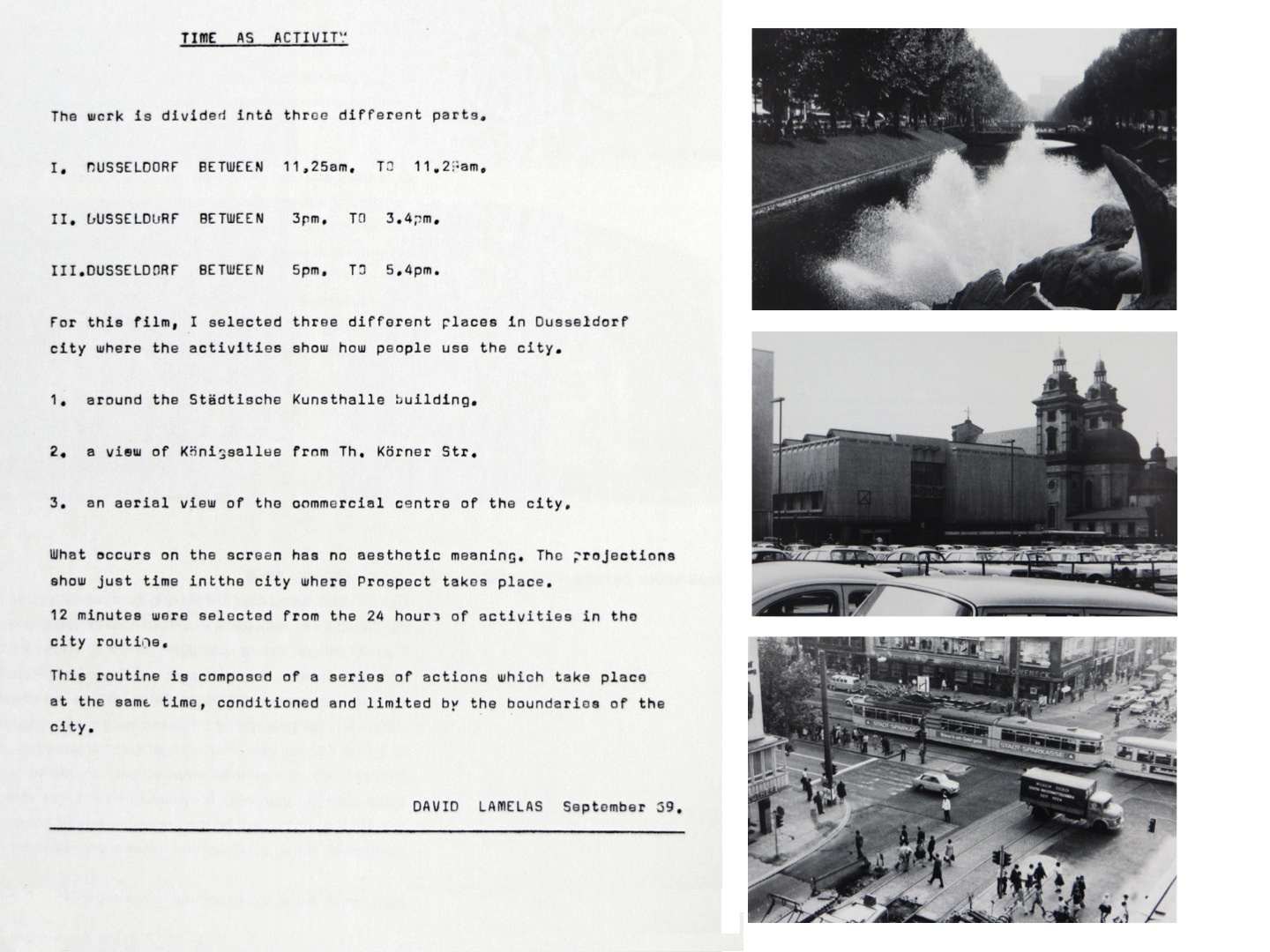
David Lamelas, Time as Activity, 1969. Descriptif et 3 photographies présentées avec les 3 films, “Prospect 69”, Düsseldorf, 1969. Courtesy Sprüth Magers London © David Lamelas.
The first film of Time as Activity, made on the occasion of Prospect 69 [texte et les trois photographies qui accompagnaient les films], in Düsseldorf, was constituted by three four-minute sequences recorded in three well-defined places around the city, from a fixed viewpoint. The following year, in Milan, in street close to the Françoise Lambert gallery, where he was going to exhibit, Lamelas made a short film and eleven photos, taken at regular intervals. The ensemble, the film and the photos, is titled Gente di Milano. This title evokes neo-realism. But Lamelas based his protocol on the mechanical capture of surveillance cameras. The beauty of these films and photographs, which could be observed recently in the hanging of a new ensemble at Lia Rumma in Milan, is related to the double game established between the juxtaposition of the places and the duration of the sequences. Since the late 1960s the example of the surveillance camera has been taken up by many other artists, to the point of saturation. But it is true that this apparatus for observation and visual capture sums up the power of control exercised via the image in the urban environment.
Time as Activity is at once an exorcism of control and a way of overcoming the limits of subjective expression reduced to the role of outlet. In a context of imaginary saturation, the model of the impersonal recording had and retains the advantage of substituting mechanisms of random invention for compulsive forms of aesthetic appropriation and for the stale discoveries of improvisation. Time as Activity manifests an attitude of anti-lyrical contemplation which was and remains decisive in the transformations of pictorial culture since the invention of photography. Conceptual anti-lyricism contains an echo of Williams’s words, No ideas but in things.
Lamelas’s protocol apparently neutralises all possibility of territorial intimacy. But in doing so, it puts aside the conventions of idiosyncratic picturesque as well as the overloads of sentimental imagery. Now, these two tendencies bring back behaviours and an imaginary saturation that obstruct the experience of territorial intimacy. Recording, according to Lamelas, stems from an ambiguous analogy between ritual performance and the mechanisms of control. This ambiguity is bound up with a definition of poetry. We can also locate or make it intervene in the history of ritual forms interpreted by primitivisms.
There are in effect, on this side of the world, where we find ourselves, all kinds of rituals attached to the production and reception (or consumption) of images. But religious rituals, which produce their own images, have become increasingly rare. This is the context in which ethnology has developed. Ethnologists have discovered exotic rituals loaded, sometimes overloaded with lived, performed images. A figure masked from head to toe [deux écrans] acts as a living image of the spirit; the living image is a mechanisation and actualisation of the spirit. According to Victor Turner, ethnologists have often ignored rituals. They had no desire to think about them. Likewise, the image, and in particular the photographic document, made them uncomfortable: they had no desire to think about them 12. In both cases, they maintained and blindly accepted the exoticism of their own culture.
Thanks to authors like Turner, the situation has progressed as regards the study of rituals (or what remains of them). It is no doubt by this procedure that the ethnographic image has been able to escape the two models from the colonial era: the portrait as study of racial anthropometry and the exotic picturesque. I will not go back over the images by Pierre Clastres published in Chronique des Indiens Guayaki. I could take other examples, but perhaps not that many. Racist colonial imagery indeed presents surprising diversity: a given effigy seems not to be contained in its assigned frame, and yet the portrait was supposed to confirm or accomplish a strict spatial subjection.
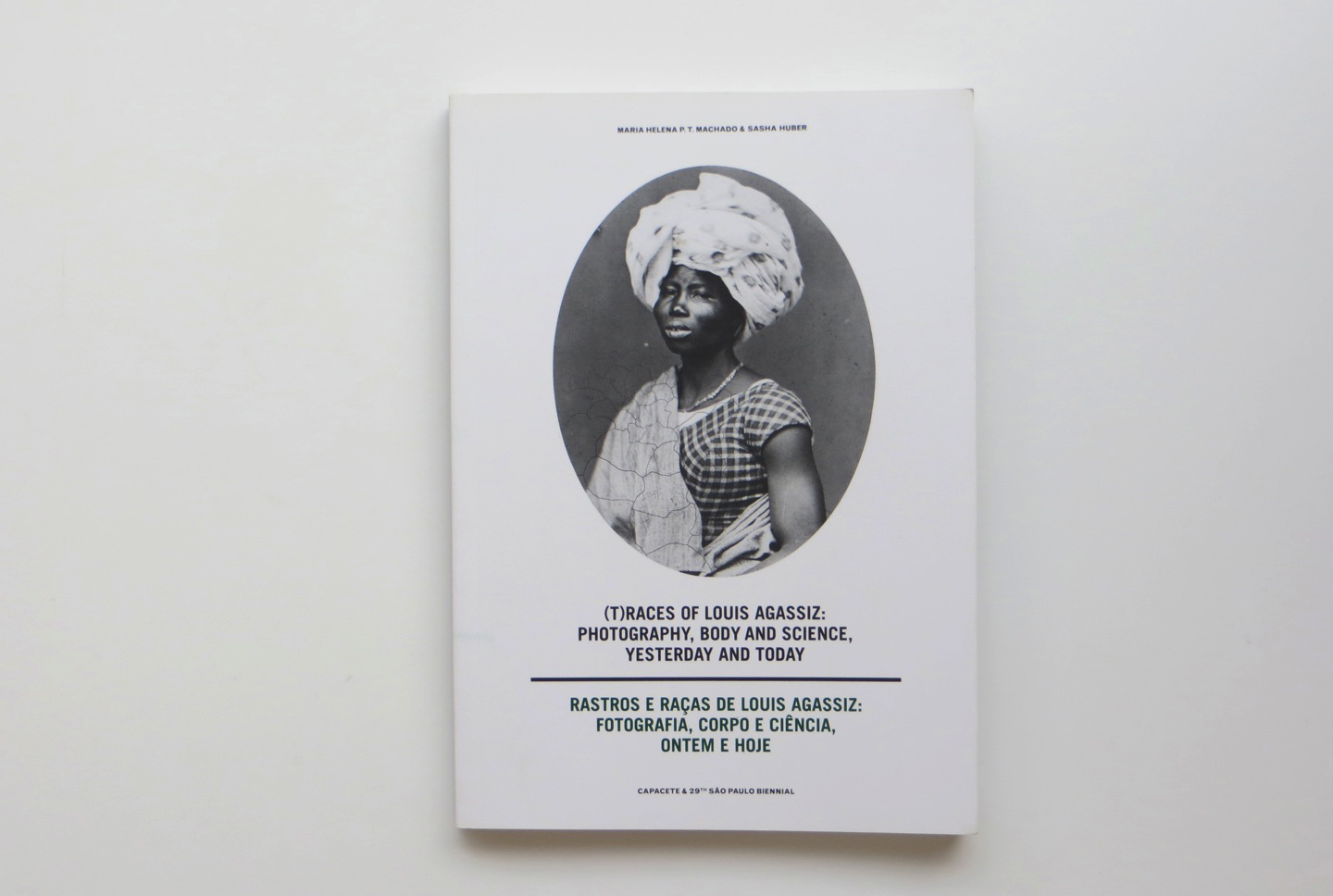
Maria Helena P.T. Machado & Sasha Huber, (T)races of Louis Agassiz: Photography, Body and Science, Yesterday and Today / Rastros e raças de Louis Agassiz: fotografia, corpo e ciência, ontem e hoje, Capacete Entretenimentos / 29e Biennale de São Paulo, 2010.
I am thinking, in particular, of the portraits commissioned by the Swiss naturalist Louis Agassiz during an expedition to Brazil in 1865-66 (Thayer expedition). Kept at the Peabody Museum at Harvard University, these images remained unpublished until 2010, when forty of them were printed in a Brazilian book 13. The best-known images in the Peabody’s Agassiz photography collection are no doubt the portraits of Black slaves born in the United States – daguerreotypes commissioned from 1850 onwards from Joseph T. Zealy, who had a studio in South Carolina (here we are at the turn of the 1850s).
The photographs of the Thayer expedition belong with an extensive project of comparative anthropology that their patron did not complete. They were meant to serve as a visual support for a comparative study of the Brazilian population carried out in keeping with the principles of racial anthropology. The models are divided into two groups: representatives of “pure races” and those of “mixed races.” The images were taken in a context of debate exacerbated by the Civil War (1861-1865) in North America. The Swiss anthropologist was both an abolitionist and a racist: he firmly condemned racism, but as a polygenist he was a supporter of segregation, which he saw as a bulwark against the deleterious mixing of races. It is clear that the severe discipline of the posed portrait was, in the practice of anthropological investigation, an auxiliary of the mechanism of objectification of racial differences, doubled with picturesque or voyeuristic effects. In the general procedure followed by the photographers, the portraits commissioned by Agassiz confirm this schema. But the pathos related to the circumstances of the photography has been condensed in an effect of the figures’ presence, which exceeds both the inventory of differences and picturesque embellishment.
Like the portraits commissioned by Louis Agassiz, the manifestations of a ritual sociality in primitive societies was bound to contradict the productive rationality to which the utilitarian body was subjected in industrial societies. The aim of ritual is generally to ensure or re-establish an equilibrium of the vital functions of the individual or collective body. It is a way of conciliating the soul of the ancestors or of clearing up discord between the living and the dead. In The Ritual Process, Victor Turner describes one of the “rituals of procreation,” Isoma, practised by a Bantu tribe of Northwest Zambia, the Ndembu. This rite is curative, it aims to dissipate a sterility crisis afflicting women who offend the shades of their ancestors. Tuner describes the formation and use of this ritual domain where fecundity is reconstituted. Description is accompanied by a handful of images, including one of a couple half-buried in the earth, which irresistibly evokes a baptismal scene.
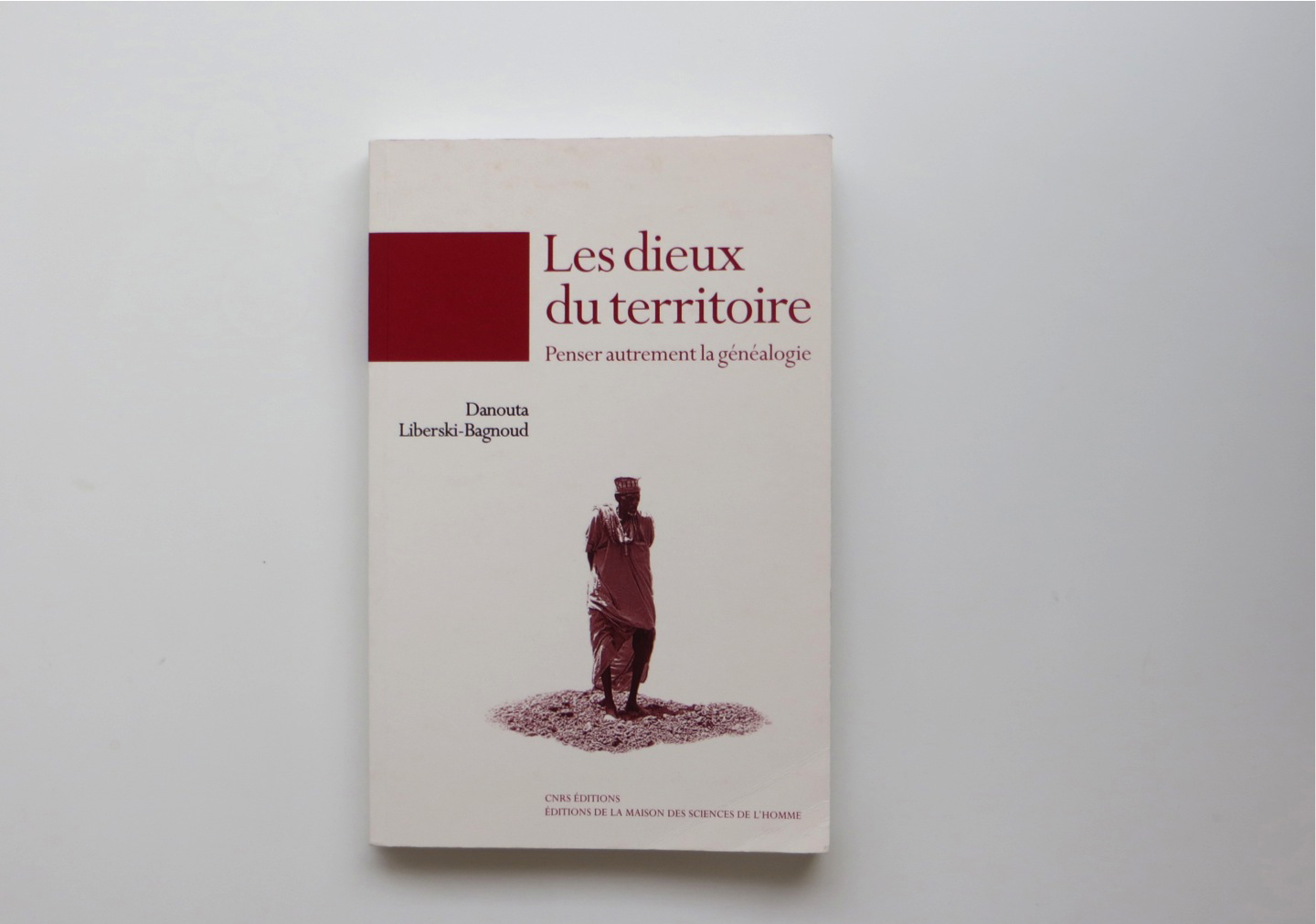
Danouta Liberski-Bagnoud, Les Dieux du territoire. Penser autrement la généalogie, Paris, CNRS Éditions, 2012.
It would be interesting to see, by taking a few examples, how territorial intimacy can depend on the choice of holy places, linked to ritual practices. I was planning to refer to the study by Danouta Liberski-Bagnoud, Les Dieux du territoire 14. We would also need to consider the question of vernacular architecture, which this book in fact shows in a new light by linking it to the ritual treatment of genealogical connections. But the example of the Ndembu is eloquent in itself: it indicates that the territorial intimacy instituted by a curative ritual presents a critical dimension in that it results from a state of crisis. Territorial intimacy is critical because it is a response to a crisis. As we saw last December, this is borne out in the images of Antonios Loupassis. These images are independent of any kind of ritual institution, and yet they do derive from an activity that corresponds and responds to a ritualization of everyday habits, one that may be more or less restrictive.
The ritual treatment of a crisis situation is a vector of territorial intimacy. But this model has its limits. I have signalled the tendency of images of crisis to become confined in patterns of rhetorical dramatization. Furthermore, as the rightful exercise of a capacity for judgement, critique cannot be only the effect of a crisis situation; it presupposes a reflexive return and projection. Now, this twofold movement stands apart from images of order and fecundity in accord with the cycle of nature or the organisation of the cosmos. Critical thought averts (or keeps at a distance) the appeal to a principle of organic cohesion. Because it induces an image of the socialised body, territorial intimacy, when coupled with critical thought, is the best antidote to the imaginary of the community as a constituted, exclusive body.
Jean-François Chevrier, 2014
Translated by Charles Penwarden
References




